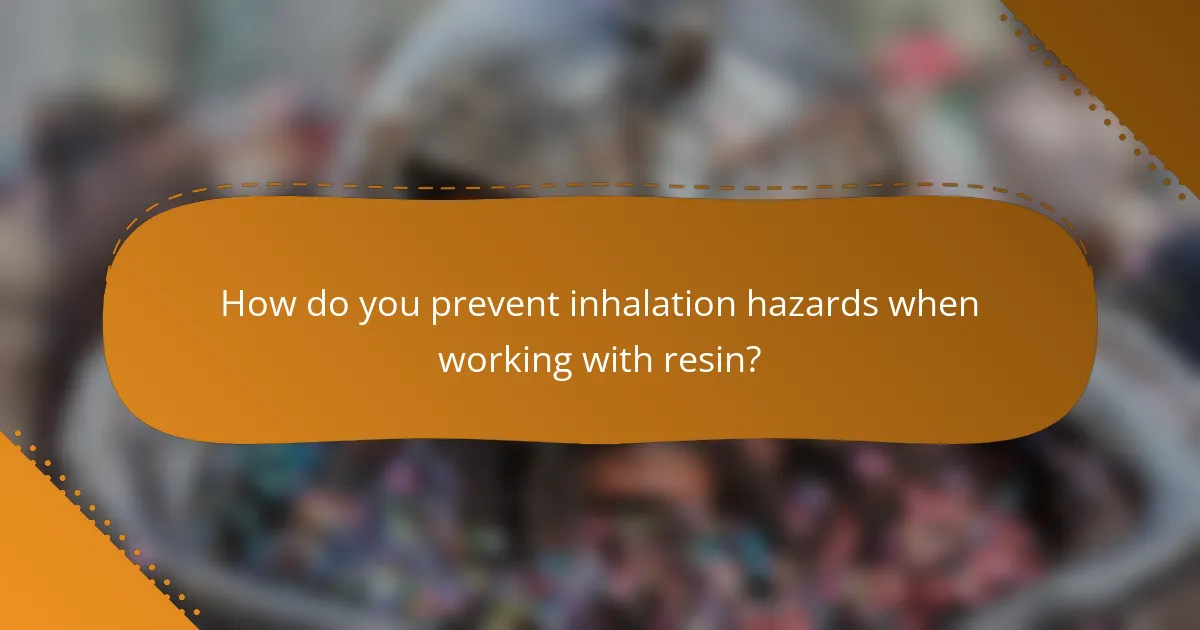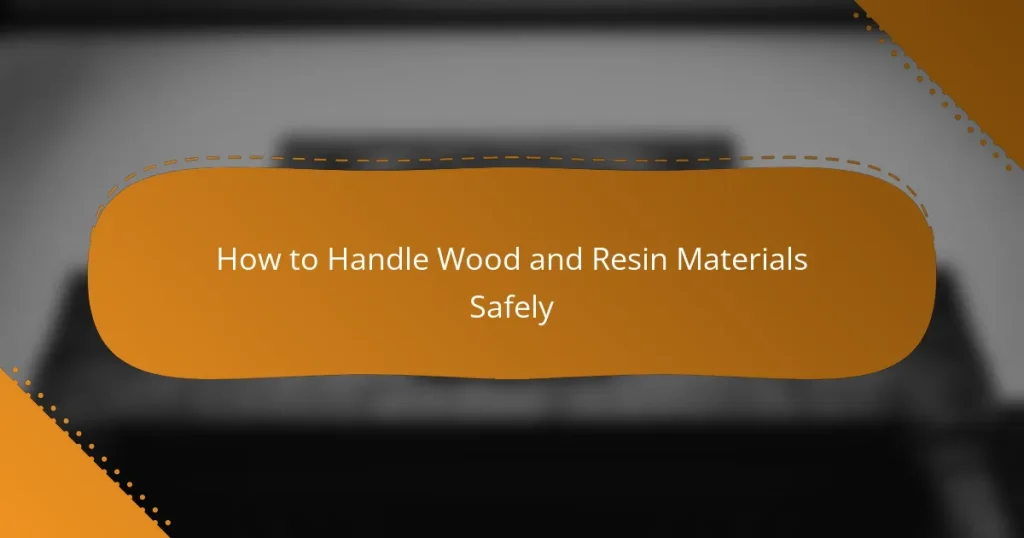Handling wood and resin materials safely is crucial to prevent injuries and health hazards. By prioritizing personal protective equipment, employing proper cutting techniques, and maintaining a clean workspace, you can significantly reduce risks associated with dust, sharp tools, and chemical exposure. Ensuring a safe environment not only protects you but also enhances the quality of your work.

How can you safely handle wood and resin materials?
To safely handle wood and resin materials, prioritize personal protective equipment, proper cutting techniques, workspace cleanliness, and correct storage methods. These practices help minimize risks associated with dust, sharp tools, and chemical exposure.
Use personal protective equipment
Wearing appropriate personal protective equipment (PPE) is essential when working with wood and resin. This includes safety goggles to protect your eyes from dust and debris, gloves to prevent skin irritation from resin, and a dust mask or respirator to avoid inhaling harmful particles.
Ensure that your PPE fits well and is in good condition. Regularly inspect your gear for any signs of wear and replace it as necessary to maintain safety standards.
Follow proper cutting techniques
Using the correct cutting techniques is crucial for safety and precision when handling wood and resin. Always use sharp tools, as dull blades can slip and cause accidents. Secure the material firmly before cutting to prevent movement.
When using power tools, follow the manufacturer’s instructions and maintain a steady hand. Avoid distractions and keep your focus on the task to reduce the risk of injury.
Maintain a clean workspace
A clean workspace is vital for safe handling of wood and resin materials. Regularly remove dust, shavings, and debris to prevent slips and falls. Organize tools and materials to minimize clutter and ensure easy access to what you need.
Consider using a vacuum or dust collection system to manage airborne particles effectively. This not only keeps the area tidy but also protects your health by reducing inhalation of harmful substances.
Store materials correctly
Correct storage of wood and resin materials is important for safety and longevity. Store wood in a dry, well-ventilated area to prevent warping and mold growth. For resin, keep it in a cool, dark place, away from direct sunlight and heat sources.
Use labeled containers for smaller items and ensure that heavier materials are stored at waist height to avoid lifting injuries. Regularly check storage areas for any signs of damage or deterioration to maintain a safe environment.

What safety equipment is essential for working with wood and resin?
When working with wood and resin, essential safety equipment includes safety goggles, respirators, and gloves. These items protect against harmful dust, fumes, and potential injuries, ensuring a safer working environment.
Safety goggles
Safety goggles are crucial for protecting your eyes from flying debris and harmful particles generated during cutting, sanding, or mixing resin. Look for goggles that provide a snug fit and meet ANSI Z87.1 standards for impact resistance.
When selecting safety goggles, consider options with anti-fog and scratch-resistant coatings to maintain visibility. Ensure they are comfortable enough for extended wear, especially during long projects.
Respirators
Respirators are vital for filtering out harmful fumes and dust when working with resin and wood. A half-mask respirator with organic vapor cartridges is typically recommended for resin work, while a particulate filter can help with wood dust.
Always check the respirator’s fit and ensure it creates a proper seal around your face. Regularly replace filters according to the manufacturer’s guidelines to maintain effectiveness.
Gloves
Wearing gloves protects your hands from sharp tools and hazardous materials, including resin, which can cause skin irritation. Nitrile gloves are a popular choice as they provide a good balance of dexterity and chemical resistance.
Ensure the gloves fit well and are free of tears or punctures. Consider using cut-resistant gloves when handling sharp tools or materials to prevent injuries.

What are the best practices for cutting wood and resin?
To cut wood and resin safely, it’s essential to follow best practices that minimize risks and ensure clean cuts. Key practices include using sharp tools, securing materials properly, and working in well-ventilated areas to avoid inhaling harmful dust or fumes.
Use sharp tools
Using sharp tools is crucial for effective cutting of wood and resin. Dull blades require more force, increasing the risk of slips and accidents. Regularly sharpen saw blades, knives, and other cutting instruments to maintain efficiency and safety.
For wood, consider using a fine-toothed saw or a sharp utility knife, while for resin, specialized cutting tools designed for composite materials can provide better results. Always inspect tools before use to ensure they are in good condition.
Secure materials properly
Securing materials is vital to prevent movement during cutting, which can lead to injuries or uneven cuts. Use clamps or a vise to hold wood and resin firmly in place. This stability allows for more precise cuts and reduces the likelihood of accidents.
When working with larger pieces, consider using a workbench with built-in clamps or a dedicated cutting station. Always check that the material is stable before starting to cut.
Cut in well-ventilated areas
Cutting wood and resin generates dust and fumes that can be harmful if inhaled. Always work in well-ventilated areas to ensure adequate airflow. If working indoors, open windows and use fans to circulate air, or consider using a dust extraction system.
For projects involving resin, ensure that the workspace is free from flammable materials and that you are using appropriate personal protective equipment (PPE), such as masks and goggles, to safeguard against inhalation of harmful particles.

How do you prevent inhalation hazards when working with resin?
To prevent inhalation hazards when working with resin, use proper ventilation and protective equipment. This includes wearing masks designed to filter out harmful particles and ensuring that your workspace is well-ventilated to reduce airborne contaminants.
Use fume extraction systems
Fume extraction systems are essential for removing harmful vapors and particles from the air while working with resin. These systems can be portable or fixed, and they work by drawing air through filters that capture toxic substances before they can be inhaled. When choosing a system, look for one that meets local safety standards and is suitable for the volume of resin you plan to use.
Regular maintenance of the extraction system is crucial to ensure its effectiveness. Check filters frequently and replace them as needed to maintain optimal airflow and filtration efficiency.
Work outdoors when possible
Working outdoors significantly reduces the risk of inhaling harmful fumes from resin. Natural ventilation helps disperse vapors, making it a safer option compared to enclosed spaces. If you choose to work outside, select a location away from populated areas to minimize exposure to others.
However, be mindful of weather conditions. Avoid working in high winds or extreme temperatures, as these can affect the curing process of the resin and your overall safety. Always have a plan for inclement weather to ensure a safe working environment.

What are the risks associated with resin exposure?
Resin exposure can pose several health risks, particularly through skin contact and inhalation. Understanding these risks is crucial for anyone working with wood and resin materials to ensure safe handling practices.
Skin irritation
Skin irritation is a common risk when handling resin, which can cause redness, itching, or rashes upon contact. Individuals with sensitive skin may experience more severe reactions, so wearing protective gloves is essential.
To minimize skin irritation, consider using barrier creams and ensure that any resin spills are cleaned promptly. If irritation occurs, wash the affected area with soap and water and seek medical attention if symptoms persist.
Respiratory issues
Inhalation of resin fumes can lead to respiratory issues, including coughing, wheezing, and shortness of breath. These symptoms can be exacerbated in poorly ventilated areas, making proper ventilation crucial when working with resin.
Using a respirator with appropriate filters can help protect against harmful vapors. Always work in a well-ventilated space, and consider using local exhaust ventilation to further reduce exposure to airborne particles and fumes.


